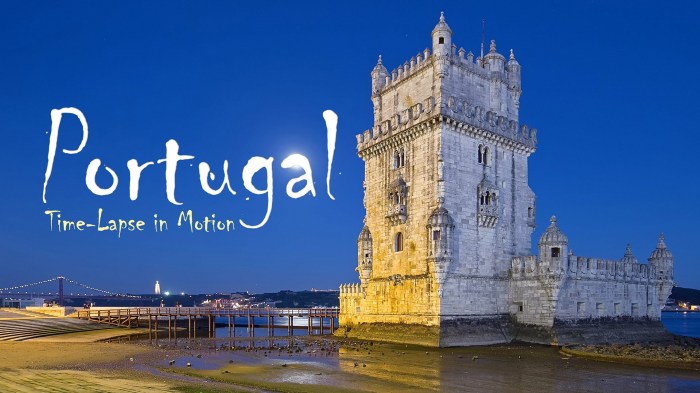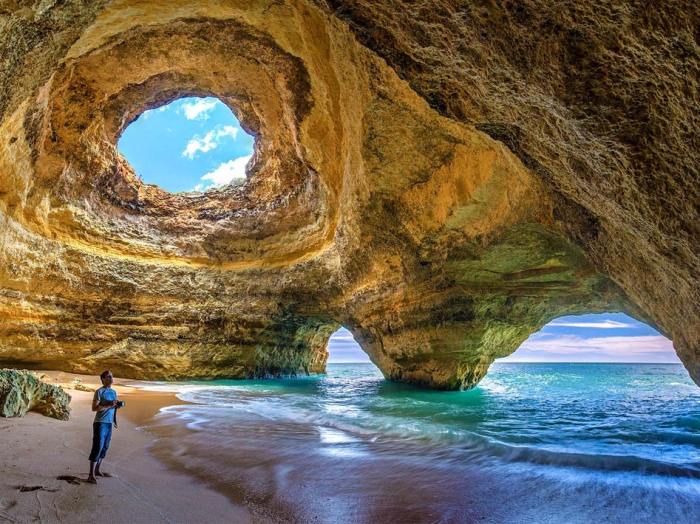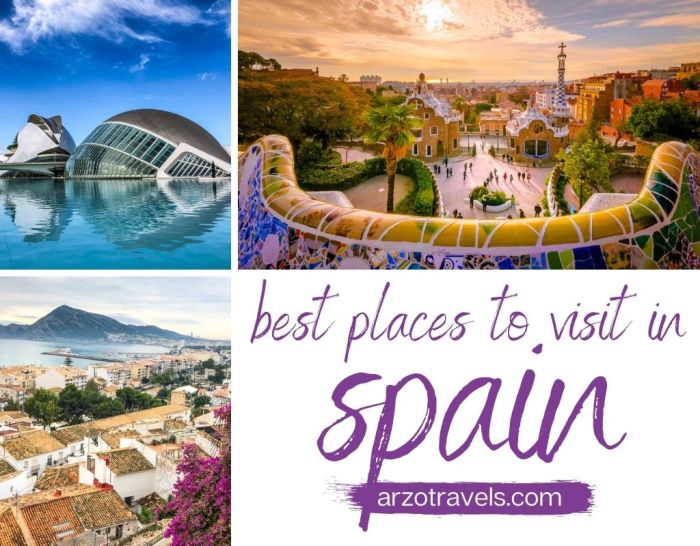Top 10 Places To Visit In Portugal
Top 10 Places To Visit In Portugal – From sun-kissed beaches to historic castles, Portugal offers a vibrant tapestry of experiences. Get ready to explore ancient Roman ruins, sip on world-renowned port wine, and wander through charming medieval towns.
Whether you’re a history buff, a beach lover, or a foodie, this captivating country has something for everyone.
This article dives into the top 10 must-see destinations, each offering a unique glimpse into Portugal’s rich history, diverse landscapes, and vibrant culture. We’ll explore the bustling capital of Lisbon, the charming city of Porto, the magical mountain town of Sintra, and much more.
Get ready to be inspired by the beauty and allure of Portugal!
Portugal: A Destination for Every Traveler
Portugal, nestled on the Iberian Peninsula, is a captivating destination that effortlessly blends ancient history with modern charm. From the sun-drenched beaches of the Algarve to the rugged beauty of the Serra da Estrela mountains, Portugal boasts diverse landscapes that cater to every traveler’s taste.
Its rich history, evident in the medieval castles, Moorish architecture, and cobblestone streets, weaves a tapestry of stories waiting to be discovered.
This article delves into the top 10 places to visit in Portugal, highlighting its unique attractions, cultural experiences, and culinary delights. Whether you seek adventure, relaxation, or a glimpse into the past, Portugal promises an unforgettable journey.
Top 10 Places to Visit in Portugal
From the bustling capital city to the serene countryside, Portugal offers a wealth of experiences. This list showcases the most captivating destinations that capture the essence of this enchanting country.
Lisbon
The Vibrant Capital
The Vibrant Capital

Lisbon, Portugal’s captivating capital, is a vibrant city where history meets modernity. It’s a place where cobblestone streets wind through historic neighborhoods, and stunning views of the Tagus River greet you at every turn. Lisbon is a city that embraces its rich past while looking towards the future.
Historic Neighborhoods
Lisbon is a city steeped in history, with neighborhoods that tell stories of centuries past. Two of the most iconic are Alfama and Bairro Alto. Alfama, the oldest neighborhood in Lisbon, is a labyrinth of narrow, winding streets. It’s a charming place filled with traditional Portuguese architecture, colorful houses, and vibrant street life.
This is where Fado, Portugal’s melancholic folk music, originated. You can hear it in the small, intimate bars and restaurants throughout the neighborhood. Bairro Alto, on the other hand, is known for its lively atmosphere. It’s a hub for Lisbon’s nightlife, with bars, clubs, and restaurants that stay open late into the night.
Bairro Alto is also home to many art galleries and boutiques, making it a great place to explore the city’s creative side.
Iconic Landmarks
Lisbon is home to several iconic landmarks that showcase its architectural heritage. Two of the most prominent are the Jerónimos Monastery and the Belém Tower. The Jerónimos Monastery, a UNESCO World Heritage Site, is a masterpiece of Manueline architecture, a distinctive Portuguese style that flourished in the 16th century.
Portugal is packed with amazing spots, from the historic castles of Sintra to the vibrant streets of Lisbon. If you’re looking for a little inspiration for your next trip, check out our list of the Top 10 Places To Visit In Portugal.
And if you’re planning a US adventure, you might want to browse through Top 25 Places To Visit In The USA to find some incredible destinations, like the Grand Canyon or Yosemite National Park. But no matter where you decide to go, you’re sure to have an unforgettable experience!
Its intricate carvings, elaborate decorations, and soaring arches are a testament to the craftsmanship of the era.The Belém Tower, also a UNESCO World Heritage Site, stands majestically on the banks of the Tagus River. This fortified tower, built in the 16th century, served as a defense against invaders and a symbol of Portuguese power.
Today, it’s a popular tourist attraction, offering breathtaking views of the river and the city.
Vibrant Nightlife, Cuisine, and Cultural Attractions
Lisbon’s nightlife is as diverse as its neighborhoods. From traditional Fado bars to modern nightclubs, there’s something for everyone. The city’s vibrant nightlife is a reflection of its energetic spirit. Lisbon’s cuisine is a delight for the senses. Fresh seafood, flavorful stews, and sweet pastries are just a few of the culinary treasures you’ll encounter.
The city’s many restaurants, from traditional taverns to Michelin-starred establishments, offer a taste of Portugal’s culinary heritage.Lisbon is also a city that embraces its culture. The city’s museums, theaters, and art galleries offer a glimpse into Portugal’s rich history and artistic traditions.
From the Calouste Gulbenkian Museum, with its impressive collection of art and artifacts, to the National Museum of Ancient Art, which showcases Portuguese art from the Middle Ages to the 19th century, Lisbon’s cultural attractions are a testament to its vibrant heritage.
Porto
The City of Bridges and Wine
The City of Bridges and Wine
Porto, Portugal, is a captivating city nestled along the Douro River, renowned for its rich history, stunning architecture, and, of course, its world-famous port wine. The city’s story is deeply intertwined with the Douro Valley, a region known for its picturesque vineyards and centuries-old winemaking traditions.
The Iconic Bridges of Porto
The Douro River divides Porto into two distinct areas, creating a dramatic landscape that has been shaped by a series of iconic bridges. These bridges are not only functional but also architectural masterpieces that reflect the city’s evolution and engineering prowess.
- Dom Luís I Bridge:Designed by Gustave Eiffel, the architect behind the famous Eiffel Tower in Paris, the Dom Luís I Bridge is a double-decker marvel. The upper level accommodates a train line, while the lower level is a pedestrian walkway offering breathtaking views of the city and the river.
The bridge’s intricate ironwork and graceful curves make it a true symbol of Porto’s industrial past and architectural innovation.
- Ponte de D. Maria Pia:This elegant steel arch bridge, also designed by Gustave Eiffel, was built in the late 19th century to connect Porto with Vila Nova de Gaia, the city on the opposite bank of the Douro. The bridge’s graceful form and innovative design for its time earned it recognition as a pioneering engineering achievement.
- Ponte Infante D. Henrique:This bridge, built in the early 20th century, is a beautiful example of reinforced concrete architecture. Its distinctive arch design and graceful curves have made it a popular landmark in Porto.
Port Wine Cellars and Wine Tasting
Porto is synonymous with port wine, a fortified wine produced in the Douro Valley and aged in the city’s historic cellars. These cellars, often located along the riverbanks, offer visitors a glimpse into the winemaking process and a chance to sample some of the region’s finest wines.
- Cellar Tours:Many cellars offer guided tours that take visitors through the winemaking process, from the vineyards to the barrels where the wine ages. These tours provide a fascinating insight into the history and tradition of port wine production.
- Wine Tastings:The highlight of any visit to a port wine cellar is the opportunity to taste the different types of port wine. From the sweet and fruity Ruby Port to the complex and aged Tawny Port, there is a style of port wine to suit every palate.
- Wine Pairing Experiences:Some cellars offer wine pairing experiences, where visitors can sample port wines alongside traditional Portuguese dishes. This is a great way to appreciate the nuances of port wine and its versatility as a food pairing.
Sintra
A Magical Mountain Town
A Magical Mountain Town
Nestled in the foothills of the Serra de Sintra mountains, just a short train ride from Lisbon, lies the enchanting town of Sintra. This captivating destination has earned its place as a UNESCO World Heritage Site, thanks to its captivating blend of history, nature, and architecture.
Sintra’s magical atmosphere is evident in its fairytale-like castles and palaces, its lush forests, and its breathtaking natural beauty.
The Fairytale Castles and Palaces of Sintra
Sintra is renowned for its collection of castles and palaces, each with its unique charm and captivating history. These structures are not mere historical remnants but are architectural masterpieces that seem to have sprung from the pages of a fairytale.
The most prominent of these is the Pena National Palace, perched atop a hill overlooking the town. This colorful palace, with its whimsical towers and turrets, is a testament to the Romantic era. It was built in the 19th century by King Ferdinand II, who transformed a former monastery into a grand residence.
The palace’s vibrant facade, adorned with intricate details and vibrant hues, is a visual feast, showcasing the creative spirit of the era. Another captivating palace is the Quinta da Regaleira, a sprawling estate with hidden gardens, secret passages, and symbolic structures.
Portugal’s got beaches, castles, and delicious food, but if you’re looking for something a little different, you should check out Romania. They have some amazing historical sites and beautiful landscapes, like the Carpathian Mountains. If you’re into medieval architecture, be sure to check out Top 10 Places To Visit In Romania.
But don’t forget, Portugal’s got some killer beaches and tasty seafood, so don’t forget to grab some pastel de nata while you’re there!
This palace is a testament to the esoteric beliefs and symbolism of the early 20th century. The Initiation Well, a spiral staircase leading down into the earth, is a prime example of the mystical elements incorporated into the design. The Chapel, with its intricate carvings and stained glass windows, further reinforces the estate’s spiritual significance.
The Unique Natural Beauty of Sintra
Beyond its captivating architecture, Sintra’s natural beauty is equally captivating. The town is nestled within a lush forest, offering a serene escape from the bustling city. The Moorish Castle, perched atop a hill overlooking the town, offers breathtaking panoramic views of the surrounding countryside.
This ancient fortress, built in the 10th century by the Moors, provides a glimpse into the region’s rich history. The castle’s ramparts and towers offer stunning views of the town and the surrounding hills.
The Cultural and Historical Significance of Sintra
Sintra’s unique charm has attracted artists, writers, and poets for centuries. Its picturesque landscapes and mystical atmosphere have inspired countless works of art and literature. The town’s cultural heritage is evident in its numerous museums, art galleries, and cultural events.Sintra’s history is as captivating as its architecture.
Portugal is known for its stunning beaches, historical cities, and delicious food, but if you’re looking for a more off-the-beaten-path adventure, check out the Faroe Islands! The Top 10 Places To Visit In The Faroe Islands list is packed with dramatic landscapes and charming villages, and after exploring the islands, you’ll be ready to head back to Portugal for some sun and sangria.
The town has been ruled by various civilizations, each leaving their mark on the region. From the Romans to the Moors to the Portuguese, Sintra’s history is a tapestry woven with diverse threads. The town’s rich past is evident in its numerous historical monuments, including the Pena National Palace, the Quinta da Regaleira, and the Moorish Castle.
Algarve
The Sun-Kissed Coast
The Sun-Kissed Coast
The Algarve region in southern Portugal is a paradise for beach lovers and those seeking sun, sand, and endless summer vibes. Its stunning coastline boasts golden beaches, dramatic cliffs, and crystal-clear waters, making it a popular destination for tourists from all over the world.
Popular Destinations
The Algarve is home to numerous charming coastal towns and villages, each offering a unique blend of history, culture, and natural beauty.
- Lagos: This vibrant town is known for its picturesque harbor, dramatic rock formations, and a wide range of water sports activities. Lagos is also home to the Ponta da Piedade, a stunning natural landmark featuring towering cliffs, sea caves, and hidden grottos.
- Albufeira: This bustling resort town is a popular choice for families and those seeking a lively nightlife. It boasts a wide range of beaches, restaurants, bars, and shops, along with numerous attractions such as the Albufeira Old Town, the Marina, and the Zoomarine Algarve, a marine animal park.
- Praia da Marinha: This beach is often cited as one of the most beautiful in Portugal and Europe. It’s renowned for its dramatic rock formations, hidden coves, and turquoise waters. The Praia da Marinha is a popular destination for hiking, swimming, and simply enjoying the breathtaking scenery.
Water Sports and Activities
The Algarve’s warm waters and consistent winds make it a haven for water sports enthusiasts.
- Sailing: The Algarve offers a variety of sailing opportunities, from leisurely cruises along the coast to challenging races and regattas. The region’s calm waters and consistent winds make it an ideal location for beginners and experienced sailors alike.
- Windsurfing and Kitesurfing: The Algarve’s strong winds, particularly in the summer months, create excellent conditions for windsurfing and kitesurfing. Popular spots include Sagres, Lagos, and Praia da Rocha.
- Scuba Diving and Snorkeling: The Algarve’s clear waters and diverse marine life make it a great destination for scuba diving and snorkeling. The region is home to a variety of underwater caves, shipwrecks, and colorful coral reefs.
Golfing in the Algarve
The Algarve is also a renowned golfing destination, boasting some of the best courses in Europe. The region’s mild climate and stunning scenery make it an ideal place to enjoy a round of golf year-round.
- The Oceanico Victoria Golf Course: This world-renowned course, designed by Ernie Els, offers breathtaking views of the Atlantic Ocean and challenging play for golfers of all levels. It has hosted several prestigious tournaments, including the Portuguese Open.
- The Quinta do Lago Golf Course: This course is known for its challenging layout and beautiful natural surroundings. It features a variety of holes, from rolling fairways to dramatic water features, making it a memorable experience for any golfer.
- The Vale do Lobo Royal Golf Course: This course is considered one of the most challenging in the Algarve, with narrow fairways and strategically placed bunkers. It offers stunning views of the ocean and the Ria Formosa lagoon.
Exploring the Algarve’s Natural Beauty
Beyond the beaches, the Algarve offers a range of opportunities to explore its natural beauty.
- The Ria Formosa Natural Park: This unique ecosystem is a network of lagoons, salt marshes, and islands, home to a wide variety of bird species, including flamingos, herons, and terns. Visitors can explore the park by boat, kayak, or bike, enjoying the tranquility and beauty of this natural wonder.
- The Serra de Monchique: This mountain range in the western Algarve offers stunning views and opportunities for hiking, cycling, and exploring the region’s unique flora and fauna. The Serra de Monchique is also home to several charming villages and traditional restaurants, offering a glimpse into the Algarve’s rural heritage.
- The Grottos of Benagil: These dramatic sea caves, carved by the relentless force of the ocean, are a must-see for any visitor to the Algarve. Visitors can explore the grottos by boat, kayak, or even by swimming, marveling at the natural beauty and unique formations.
Évora
A Historic City with Roman Ruins
A Historic City with Roman Ruins
Évora, a UNESCO World Heritage Site, is a captivating city in southern Portugal that seamlessly blends Roman ruins with medieval architecture, offering a glimpse into the country’s rich history. This ancient city, once a Roman municipium, boasts impressive Roman ruins and captivating medieval architecture that whispers tales of a glorious past.
Roman Ruins and Medieval Architecture
Évora’s Roman heritage is evident in its well-preserved ruins, a testament to the city’s past as a thriving Roman settlement. The Roman Temple of Évora, also known as the Temple of Diana, is a stunning example of Roman architecture.
Constructed in the 1st century AD, the temple’s imposing columns and intricate carvings offer a glimpse into the grandeur of Roman civilization. The Roman aqueduct, which once supplied the city with water, stands as a reminder of the Romans’ engineering prowess.
The aqueduct’s towering arches and intricate design are a testament to the Romans’ ability to create practical and beautiful structures.The city’s medieval architecture, with its narrow cobblestone streets and charming squares, adds to Évora’s allure. The Évora Cathedral, a magnificent Gothic masterpiece, is a prominent landmark.
The cathedral’s towering spires and intricate stained glass windows are a testament to the craftsmanship of medieval builders. The Cathedral’s interior is adorned with exquisite sculptures and paintings, showcasing the artistry of the period.
The Chapel of Bones
The Chapel of Bones, located within the Church of São Francisco, is a unique and haunting attraction. This chapel, adorned with the bones of thousands of monks, is a stark reminder of mortality. The chapel’s walls and ceiling are covered with human bones, arranged in intricate patterns, creating a truly unforgettable experience.
Historical Significance
Évora played a significant role in Portuguese history, serving as the capital of Portugal during the 13th century. The city was a center of learning and culture, with the University of Évora founded in 1559. Évora’s strategic location and its role as a major trading center contributed to its growth and prosperity.
The city’s rich history and architectural heritage make it a must-visit destination for anyone interested in exploring Portugal’s past.
Madeira
The Island of Eternal Spring
The Island of Eternal Spring
Madeira, a Portuguese archipelago located in the North Atlantic Ocean, is a destination that captivates visitors with its breathtaking beauty and diverse landscapes. Nicknamed “The Island of Eternal Spring,” Madeira boasts a mild climate year-round, making it an ideal escape from the cold winter months.
Its lush green valleys, towering volcanic mountains, and dramatic coastline create a stunning backdrop for unforgettable experiences.
The Stunning Landscapes of Madeira
The island’s unique geological history has shaped its diverse and awe-inspiring landscapes. Lush forests blanket the valleys, home to a rich tapestry of flora and fauna. Towering volcanic mountains, like Pico Ruivo, the highest peak in Portugal, rise majestically, offering panoramic views of the island.
The coastline is equally dramatic, with rugged cliffs, hidden coves, and golden sand beaches. The contrast between the verdant interior and the rugged coastline creates a visual feast for the eyes.
The Unique Flora and Fauna of Madeira
Madeira’s isolation has led to the evolution of a unique and diverse ecosystem. The island is home to over 700 species of plants, many of which are endemic, meaning they are found nowhere else in the world. The Laurissilva forest, a UNESCO World Heritage Site, is a prime example of Madeira’s unique biodiversity.
This ancient forest is home to a variety of rare and endangered species, including the Madeira Laurel, the Madeira Partridge, and the Madeira Firecrest.
Hiking in Madeira
Madeira is a paradise for hikers, with a network of trails that wind through its diverse landscapes. From challenging climbs to gentle walks, there’s a trail for every level of fitness. The Levada walks, which follow the island’s irrigation channels, are particularly popular.
These trails offer stunning views of the valleys, waterfalls, and forests.
Wine Tasting in Madeira
Madeira is renowned for its fortified wine, which has been produced on the island for centuries. The island’s unique climate and volcanic soil create ideal conditions for growing grapes. Wine tasting tours are a popular activity for visitors, offering the chance to sample a variety of Madeira wines, from the dry and crisp to the sweet and rich.
Whale Watching in Madeira
The waters around Madeira are home to a variety of marine life, including whales, dolphins, and sea turtles. Whale watching tours are a popular way to experience the island’s rich marine biodiversity. From December to March, humpback whales migrate to the area to breed, while sperm whales can be seen year-round.
Azores
The Islands of Volcanic Beauty
The Islands of Volcanic Beauty

The Azores, a Portuguese archipelago in the North Atlantic Ocean, is a haven for nature enthusiasts. These nine volcanic islands offer breathtaking landscapes, diverse wildlife, and an abundance of outdoor activities.
Volcanic Landscapes
The Azores’ volcanic origins are evident in its dramatic landscapes. The islands are dotted with volcanic craters, many of which have filled with water to form stunning crater lakes. These lakes are often surrounded by lush vegetation, creating a picturesque setting.
The volcanic activity has also given rise to numerous hot springs, which are a popular attraction for visitors.
Unique Flora and Fauna, Top 10 Places To Visit In Portugal
The isolation of the Azores has resulted in the development of a unique flora and fauna. The islands are home to a variety of endemic species, including the Azores bullfinch, the Azores wood pigeon, and the Azores giant earthworm.
The Azores also boast a diverse array of plant life, including the endemic Azores laurel forest.
Opportunities for Adventure
The Azores offer a range of outdoor activities for visitors. The islands are ideal for hiking, with numerous trails that wind through volcanic landscapes, forests, and coastal areas. The Azores are also a prime destination for whale watching, as the waters surrounding the islands are home to a variety of whale species, including sperm whales, blue whales, and humpback whales.
In addition to whale watching, visitors can also enjoy other activities such as scuba diving, snorkeling, and kayaking.
Braga
The Religious Heart of Portugal
The Religious Heart of Portugal
Nestled in the Minho region of northern Portugal, Braga is a city steeped in history and faith, earning its nickname as the “Religious Heart of Portugal.” Known for its stunning churches and cathedrals, Braga has been a significant pilgrimage destination for centuries, attracting visitors seeking spiritual solace and architectural grandeur.
The Historical Churches and Cathedrals of Braga
Braga’s religious heritage is evident in its numerous churches and cathedrals, each with its own unique story and architectural style.
- Sé Catedral de Braga:Founded in the 11th century, the Sé Catedral de Braga is the oldest and most important cathedral in Portugal. Its Romanesque architecture, adorned with intricate carvings and stained glass windows, is a testament to the city’s rich history.
Inside, visitors can admire the ornate gold altar and the tomb of the first Archbishop of Braga, Saint Martinho.
- Bom Jesus do Monte:Perched atop Mount Espinho, the Bom Jesus do Monte is a pilgrimage site renowned for its dramatic baroque staircase and sanctuary. Built in the 18th century, the staircase, adorned with fountains and statues depicting the Passion of Christ, leads to the church, which boasts a stunning view of the city and surrounding countryside.
The Bom Jesus do Monte is a popular destination for religious pilgrims and tourists alike, offering a unique blend of religious devotion and architectural splendor.
- Igreja de São Francisco:The Igreja de São Francisco, a 14th-century Gothic church, is known for its elaborate interior, featuring intricate carvings, gilded ceilings, and a stunning cloister. The church’s most striking feature is its Manueline portal, a masterpiece of Portuguese Renaissance architecture.
- Igreja de Santa Cruz:The Igreja de Santa Cruz, a Romanesque church built in the 12th century, is notable for its beautiful cloister, which features a series of arcades and a central fountain. The church also houses a valuable collection of religious art, including paintings, sculptures, and manuscripts.
The Religious Significance of Braga
Braga’s deep religious roots are evident in its history as an important pilgrimage destination. The city’s significance as a religious center dates back to the 6th century when it was established as the seat of the Archbishop of Braga.
The city’s numerous churches and monasteries have attracted pilgrims from across Portugal and beyond, seeking spiritual guidance and blessings. Braga’s religious heritage is a vibrant part of its cultural identity, and its churches and cathedrals continue to play a vital role in the lives of its residents.
The Cultural and Historical Attractions of Braga
Beyond its religious heritage, Braga boasts a wealth of cultural and historical attractions.
- Museu dos Biscainhos:The Museu dos Biscainhos, housed in a 17th-century palace, offers a glimpse into the life and times of the Braga aristocracy. The museum’s collection includes furniture, paintings, sculptures, and other artifacts that showcase the city’s rich cultural heritage.
- The Roman Ruins:Braga’s history dates back to Roman times, and the city’s Roman ruins offer a fascinating glimpse into its past. The Roman Forum, the Roman Baths, and the Roman Walls are all well-preserved and offer a testament to Braga’s long and rich history.
- The University of Minho:The University of Minho, established in 1973, is a major cultural and educational institution in Braga. The university’s modern campus is a striking example of contemporary architecture, and its vibrant student population adds a youthful energy to the city.
Obidos
A Medieval Walled Town
A Medieval Walled Town
Step back in time and immerse yourself in the enchanting world of Óbidos, a perfectly preserved medieval town nestled in the heart of Portugal. Óbidos is a testament to the rich history and architectural brilliance of the country, offering a glimpse into a bygone era.
The Charming Walls and Cobblestone Streets
Óbidos is a living museum, its medieval walls standing tall as a symbol of its past. The town is encircled by these imposing walls, which were built in the 13th century to protect its inhabitants. As you wander through the town, you’ll be greeted by narrow cobblestone streets that wind their way through charming houses, each adorned with colorful flowers and traditional Portuguese tiles.
The streets are lined with quaint shops and cafes, inviting you to pause and soak in the ambiance.
The Historic Castle and Unique Architecture
The heart of Óbidos is its historic castle, a majestic structure that dominates the skyline. The castle, built in the 12th century, served as a royal residence for centuries and is now a museum that showcases the town’s history and culture.
Óbidos’s architecture is a blend of medieval and Renaissance styles, with buildings featuring whitewashed walls, red tile roofs, and intricate details. The town’s unique architecture reflects the influence of various periods throughout history, creating a visually stunning tapestry.
The Cultural and Historical Significance of Obidos
Óbidos has played a significant role in Portuguese history. The town was a strategic location for defense, and its walls served as a formidable barrier against invaders. In the 13th century, Óbidos was given to the Queen of Portugal as a dowry, and it became a royal residence for centuries.
The town has also been a center of cultural and religious activity, with its churches and convents attracting pilgrims and travelers alike.
Conclusion: Top 10 Places To Visit In Portugal
From the vibrant capital of Lisbon to the sun-kissed beaches of the Algarve, Portugal offers a diverse range of experiences for every traveler. Whether you’re interested in history, culture, nature, or simply relaxing on the beach, you’re sure to find something to love in this beautiful country.
Summary of Top 10 Places to Visit in Portugal
Portugal’s diverse landscape and rich history offer a wealth of travel experiences. Here’s a recap of the top 10 places to visit:
- Lisbon, the vibrant capital, boasts historic neighborhoods, stunning architecture, and a lively nightlife.
- Porto, the city of bridges and wine, is known for its picturesque Douro River and world-renowned port wine.
- Sintra, a magical mountain town, features enchanting palaces, lush gardens, and breathtaking views.
- Algarve, the sun-kissed coast, offers pristine beaches, charming fishing villages, and exciting watersports.
- Évora, a historic city with Roman ruins, is a UNESCO World Heritage Site and a testament to Portugal’s rich past.
- Madeira, the island of eternal spring, features stunning landscapes, lush forests, and a mild climate year-round.
- Azores, the islands of volcanic beauty, offer breathtaking scenery, volcanic lakes, and diverse wildlife.
- Braga, the religious heart of Portugal, is home to impressive churches, monasteries, and religious festivals.
- Óbidos, a medieval walled town, is a charming village with cobblestone streets, whitewashed houses, and a rich history.
- Douro Valley, the heart of Portuguese wine country, offers scenic vineyards, historic wineries, and breathtaking views.
Planning Your Portuguese Adventure
Portugal is a country that truly has something for everyone. Whether you’re looking for a relaxing beach vacation, a cultural adventure, or a taste of history, you’re sure to find it in Portugal. Start planning your own Portuguese adventure today!
Conclusion: Top 10 Places To Visit In Portugal
So, there you have it – a glimpse into the top 10 places to visit in Portugal. Whether you’re seeking historical wonders, breathtaking scenery, or vibrant city life, Portugal has it all. Get ready to immerse yourself in the country’s rich culture, indulge in delicious cuisine, and create unforgettable memories.
Start planning your Portuguese adventure today!
Commonly Asked Questions
What is the best time to visit Portugal?
The best time to visit Portugal depends on your preferences. Spring (April-May) and autumn (September-October) offer pleasant weather and fewer crowds. Summer (June-August) is hot and sunny, perfect for beach holidays, but expect higher prices and more tourists.
Do I need a visa to visit Portugal?
Visa requirements depend on your nationality. Citizens of most European countries and many others can enter Portugal without a visa for up to 90 days. Check the Portuguese embassy website for specific requirements.
What is the currency used in Portugal?
The official currency of Portugal is the Euro (€).
Is English widely spoken in Portugal?
While Portuguese is the official language, English is widely spoken in tourist areas, especially in major cities like Lisbon and Porto. However, learning a few basic Portuguese phrases can be helpful.
How do I get around Portugal?
Portugal has a well-developed public transportation system, including trains, buses, and trams. You can also rent a car to explore at your own pace.






